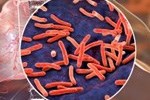Tuberculosis at the RVC - Projects
Development of rapid diagnostics to detect mycobacterial infections
Mycobacteria are very difficult to culture and can take weeks to grow. The aim of this project is to is to use novel patented bacteriophage technology to rapidly detect and diagnose infections caused by mycobacteria, such as Tuberculosis and Johne’s disease. Mycobacterial pathogens are responsible for a range of diseases in both humans and animals. TB in humans is primarily caused by M. tuberculosis and TB in cattle is primarily caused by M. bovis. Both organisms are members of the Mycobacterium tuberculosis complex group of organisms.
Functional genomics of the Mycobacterium tuberculosis complex
The Mycobacterium tuberculosis complex is comprised of a group of closely related bacteria with distinct host preferences. Species such as Mycobacterium bovis causes TB in animals, but has a wide host range. Species such as Mycobacterium tuberculosis and Mycobacterium africanum primarily cause TB in humans. Human TB is one of the top 10 causes of death from a single infectious agent and causes approximately 1.5 million deaths annually.
Epidemiology of Tuberculosis in Cattle
We study the epidemiology of tuberculosis in cattle using a combination of fieldwork and the analysis of big data. Bovine tuberculosis (bTB) is caused by infection with Mycobacterium bovis. It is the most pressing animal health problem in Great Britain. Around 40,000 cattle test bTB-positive each year and are slaughtered in an effort to control this disease. This comes at a cost to the taxpayer of around £100 million per year in surveillance testing and compensation.
Field approaches to identifying tuberculosis in badger populations
We study the epidemiology of tuberculosis in wild badgers using a combination of fieldwork, laboratory investigations and long-term data analysis.
Tuberculosis (TB) occurs worldwide and affects many animals (farmed and wild) as well as humans. In cattle, TB is caused by infection with the bacterium Mycobacterium bovis and is sometimes referred to as bovine TB.
Interactions between species: Implications for disease transmission
A study of the contact patterns between a wide range of species to better understand the risks of disease transmission between livestock, wildlife and people. Many diseases spread between species. Humans are no exception: we share most of our infectious diseases with other hosts. This means we may become infected from other species (for example, catching rabies through being bitten by an infected dog) or we may be the source of infection to other species (for example, spreading antibiotic-resistant bacteria to livestock or pets).
Machine learning algorithms for predicting drug resistance against tuberculosis in people
Tuberculosis disease (TB), caused by Mycobacterium tuberculosis, is an important global public health issue, and its drug resistance, caused by genetic mutations in the M. tuberculosis genome, poses serious challenges for effective control. Current molecular diagnostic tests are imperfect as they do not target all resistance mechanisms and drugs, nor do they inform on transmission clusters, and are therefore unable to guide completely effective individualised therapy.
Epidemiology of Tuberculosis in Meerkats of the Kalahari
Research project by the Royal Veterinary College investigating the epidemiology of Tuberculosis in meerkats in the Kalahari Desert in southern Africa.
Meerkats (Suricata suricatta) are social mammals that live in groups. A potential disadvantage of being social is that infectious diseases are more likely to spread. Tuberculosis (TB: a bacterial infection) was first detected in wild meerkats in southern Africa in the late 1990s.






